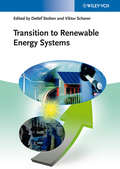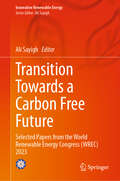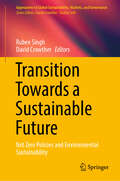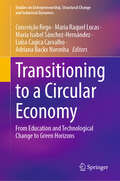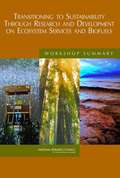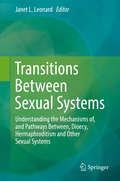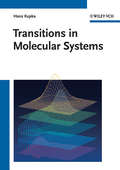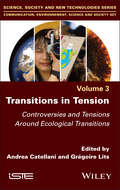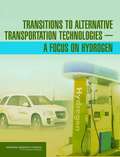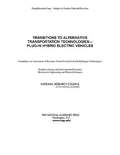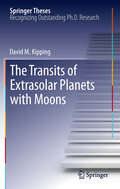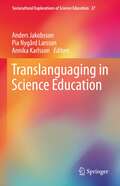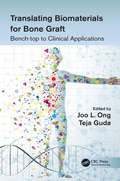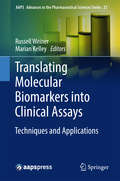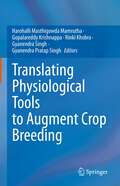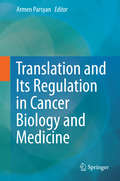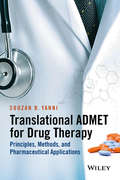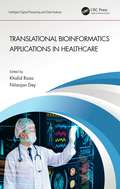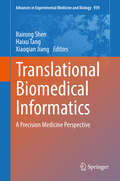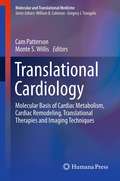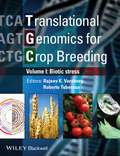- Table View
- List View
Transition to Renewable Energy Systems
by Detlef Stolten Viktor SchererIn the wake of global climate change and increasing geopolitical instability of oil supply an accelerated transition to renewable energy system gets increasingly important, if not unavoidable.This book encompasses reports of select energy strategies as well as in-depth technical information of the already or potentially involved technologies. On the one hand, it compiles the description of technologies that already proved to be game changers of the energy supply in some countries, i.e. solar, wind, biomass and hydro power, with a strong focus on data, facts and figures that are needed to design a renewable energy system for a region or a country. On the other hand, this book compiles many more technologies that bear the potential to become game changes in some regions or countries, like maritime power technologies or geothermal energy. The focus on the whole energy system involves particular consideration of storage technologies for the fluctuating renewable energy input as well as an overview on energy transportation as electrical or chemical energy. Also the end-use of the renewable energy is considered if the energy system is affected, like in automotive transportation via battery or fuel cell vehicles.Postulating climate change as a major driver for renewable energies, the articles of the book are written assuming the time-line of 2050 for a major CO2 reduction in order to fulfill the UN global warming goal of 2°C. Hence, technologies that have a potential to leave the research stage by 2030 are considered since further ten years are required for industrial development and market penetration each. Transition to Renewable Energy Systems provides specific insights for energy engineers, process engineers, chemists, and physicists, as well as a sufficiently broad scope to be able to understand the challenges, opportunities and implications of a transition to renewable energy systems so that strategies can be cast.
Transition Towards a Carbon Free Future: Selected Papers from the World Renewable Energy Congress (WREC) 2023 (Innovative Renewable Energy)
by Ali SayighThis book contains selected papers from the 22nd World Renewable Energy Congress (WREC 2023) in Kuala Lumpur. The forum promotes renewable energy global development and features top international experts, policymakers, scientists, engineers, technology developers, and business practitioners addressing the most current research in sustainable energy development and innovation. The contributions address policy, technology, and applications across a wide range of topics, including solar thermal, geothermal energy, wind energy, turbines and generators, bioclimatic architecture, energy audits, construction and design, low carbon mobility, green steel, batteries and supercapacitors, regulatory issues and public policy, circular economy, urban mining and much more.
Transition Towards a Sustainable Future: Net Zero Policies and Environmental Sustainability (Approaches to Global Sustainability, Markets, and Governance)
by David Crowther Rubee SinghThis book provides the latest research on net zero policies, environmental sustainability, and the practical implications for adopting sustainable technologies in the current scenario. Contributions from numerous academic experts explore how the sustainability transition, driven by net zero policies and sustainable technologies, promotes environmental sustainability. This book offers a unique perspective by integrating multidisciplinary ideas, techniques, and tools essential for implementing net zero policies. It aims to give readers an in-depth understanding of how these policies facilitate the transition to sustainable technologies and promote long-term environmental sustainability. A must-read for students, research scholars, and industry professionals in sustainable development, eco-friendly business management, and emerging technologies, this book presents a comprehensive concept, roadmap, and analysis of tactics and technological advancements. These strategies can propel both developed and developing countries toward net zero policies, aligning with the United Nations' urgent call to reduce carbon emissions and create a more sustainable world. Bringing together new research insights, ideas, and directions, this book guides the implementation of sustainable transitions for net zero policies.
Transition Towards Energy Efficient Machine Tools
by André ZeinEnergy efficiency represents a cost-effective and immediate strategy of a sustainable development. Due to substantial environmental and economic implications, a strong emphasis is put on the electrical energy requirements of machine tools for metalworking processes. The improvement of energy efficiency is however confronted with diverse barriers, which sustain an energy efficiency gap of unexploited potential. The deficiencies lie in the lack of information about the actual energy requirements of machine tools, a minimum energy reference to quantify improvement potential and the possible actions to improve the energy demand. Therefore, a comprehensive concept for energy performance management of machine tools is developed which guides the transition towards energy efficient machine tools. It is structured in four innovative concept modules, which are embedded into step-by-step workflow models. The capability of the performance management concept is demonstrated in an automotive manufacturing environment. The target audience primarily comprises researchers and practitioners challenged to enhance energy efficiency in manufacturing. The book may also be beneficial for graduate students who want to specialize in this field.
Transitioning to a Circular Economy: From Education and Technological Change to Green Horizons (Studies on Entrepreneurship, Structural Change and Industrial Dynamics)
by Conceição Rego Maria Raquel Lucas María Isabel Sánchez-Hernández Luísa Cagica Carvalho Adriana Backx NoronhaThis comprehensive book addresses the multifaceted challenges posed by technological innovation, ecological transitions, and sustainable business practices. Drawing on extensive research in the circular economy and green, inclusive transitions, it serves as an essential reference for scholars, researchers, and practitioners. In today’s global landscape, quality of life transcends economic indicators like GDP. True well-being and happiness are influenced by a myriad of factors beyond financial wealth. Social and environmental domains are crucial to ensuring that no individual or community is left behind. This commitment aligns with the Sustainable Development Goals (SDGs) framework, emphasizing holistic sustainability.
Transitioning To Sustainability Through Research And Development On Ecosystem Services And Biofuels: Workshop Summary
by National Research Council of the National AcademiesThe National Research Council's Roundtable on Science and Technology for Sustainability hosted "Transitioning to Sustainability through Research and Development on Ecosystem Services and Biofuels: The National Academies' First Federal Sustainability Research and Development Forum" on October 17- 18, 2007. The forum discussed sustainability research and development activities related to ecosystem services and biofuels. The objective of the forum was to identify research gaps and opportunities for collaboration among federal agencies to meet the challenges to sustainability posed by the need to maintain critical ecosystem services, to support the development of alternatives to conventional fossil fuels, and to manage oceans and coastal areas. The forum focused primarily on federal activities, but included the participation of representatives from the private sector, universities, and nongovernmental organizations. This book is a summary the discussions from the forum.
Transitions Between Sexual Systems: Understanding the Mechanisms of, and Pathways Between, Dioecy, Hermaphroditism and Other Sexual Systems
by Janet L. LeonardThis book focuses on explaining the distribution of sexual systems (simultaneous hermaphroditism, sequential hermaphroditism, environmental sex determination,dioecy, androdioecy, etc.) among taxa, which remains a major challenge in evolutionary biology. Although significant advances have been made for angiosperms, there is not yet a theory that predicts the sexual system for the majority of animal taxa, and other taxa of plants also remain poorly understood. The problem, particularly for animals, is that sexual systems can be very conservative, with whole phyla and classes being characterized by a single sexual system; for example essentially the whole phylum Platyhelminthes is simultaneously hermaphroditic, whereas the Insecta (Hexapoda) and the Tetrapoda among the vertebrates, are exclusively dioecious. Sex allocation theory on the other hand, suggests that sexual systems should be highly responsive to evolution, changing with population density, life span, patterns of resource availability, etc. The book provides an overview of the topic and then presents a series of chapters, each dealing with a taxon with substantial lability in sexual system in order to identify the factors associated with changes in sexual system in each case. By doing so, the authors reveal factors that have not been considered in formal theory but seem to have a major impact on transitions between sexual systems.This book appeals to a wide readership in fields from zoology and evolutionary biology to botany.
Transitions in Molecular Systems
by Hans J. KupkaFilling the gap for a book covering vibronic, nonadiabatic and diabatic couplings as well as radiationless processes in context, this monograph compiles classic and cutting-edge work from numerous researchers into one handy source. Alongside a description of radiationless processes in statistical large molecules and calculational methods for intramolecular distributions, the authors also investigate the nuclear coordinate dependence of matrix elements. Whole chapters are devoted to the mathematical description of the lifetime and decay of a prepared states as well as miscellaneous applications. The text is supplemented by a number of appendices for optimum usability. With its integration of the necessary mathematical rigor, this is primarily intended for graduate students in theoretical physics and chemistry, but is also indispensable reading for those working in molecular physics, physical chemistry and laser physics.
Transitions in Tension, Volume 3: Controversies and Tensions Around Ecological Transitions (ISTE Invoiced)
by Andrea Catellani Grégoire LitsTransitioning towards a more sustainable world is currently a central topic receiving a lot of attention. As a result, “transitions” are becoming key objects and the drivers of exchanges, communications and controversy in modern society. This book examines the tensions and controversies surrounding the energy, ecological and social transitions currently underway, and it draws on tools developed in the humanities and social sciences, in particular the information and communication sciences. The various case studies gathered here, written by leading experts in environmental communication, examine a wide range of topics; they explore transitions in a number of different fields, from agriculture to territorial policies, and from online and media communication to mechanisms for citizen participation. Transitions in Tension features a wealth of original observations and approaches, enabling readers to fully comprehend the range of controversies and issues facing our society
Transitions to Alternative Transportation Technologies: A Focus on Hydrogen
by National Research Council of the National AcademiesHydrogen fuel cell vehicles (HFCVs) could alleviate the nation's dependence on oil and reduce U.S. emissions of carbon dioxide, the major greenhouse gas. Industry-and government-sponsored research programs have made very impressive technical progress over the past several years, and several companies are currently introducing pre-commercial vehicles and hydrogen fueling stations in limited markets. However, to achieve wide hydrogen vehicle penetration, further technological advances are required for commercial viability, and vehicle manufacturer and hydrogen supplier activities must be coordinated. In particular, costs must be reduced, new automotive manufacturing technologies commercialized, and adequate supplies of hydrogen produced and made available to motorists. These efforts will require considerable resources, especially federal and private sector funding. This book estimates the resources that will be needed to bring HFCVs to the point of competitive self-sustainability in the marketplace. It also estimates the impact on oil consumption and carbon dioxide emissions as HFCVs become a large fraction of the light-duty vehicle fleet.
Transitions to Alternative Transportation Technologies--Plug-In Hybrid Electric Vehicles
by National Research Council of the National AcademiesFor multi-user PDF licensing, please contact customer service. The nation has compelling reasons to reduce its consumption of oil and emissions of carbon dioxide. Plug-in hybrid electric vehicles (PHEVs) promise to contribute to both goals by allowing some miles to be driven on electricity drawn from the grid, with an internal combustion engine that kicks in when the batteries are discharged. However, while battery technology has made great strides in recent years, batteries are still very expensive. Transitions to Alternative Transportation Technologies--Plug-in Hybrid Electric Vehiclesbuilds on a 2008 National Research Council report on hydrogen fuel cell vehicles. The present volume reviews the current and projected technology status of PHEVs; considers the factors that will affect how rapidly PHEVs could enter the marketplace, including the interface with the electric transmission and distribution system; determines a maximum practical penetration rate for PHEVs consistent with the time frame and factors considered in the 2008 Hydrogen report; and incorporates PHEVs into the models used in the hydrogen study to estimate the costs and impacts on petroleum consumption and carbon dioxide emissions.
The Transits of Extrasolar Planets with Moons
by David M. KippingCan we detect the moons of extrasolar planets? For two decades, astronomers have made enormous progress in the detection and characterisation of exoplanetary systems but the identification of an "exomoon" is notably absent. In this thesis, David Kipping shows how transiting planets may be used to infer the presence of exomoons through deviations in the time and duration of the planetary eclipses. A detailed account of the transit model, potential distortions, and timing techniques is covered before the analytic forms for the timing variations are derived. It is shown that habitable-zone exomoons above 0.2 Earth-masses are detectable with the Kepler space telescope using these new timing techniques.
Translanguaging in Science Education (Sociocultural Explorations of Science Education #27)
by Anders Jakobsson Pia Nygård Larsson Annika KarlssonThis edited volume explores diverse translanguaging practices in multilingual science classrooms in Hong Kong, Lebanon, Luxembourg, South Africa, Sweden and the United States. It presents novel opportunities for using students’ home, first or minority languages as meaning-making tools in science education. It also invites to explore the use of language resources and other multimodal resources, such as gestures and body language. In addition, it discusses and problematizes contingent hindrances and obstacles that may arise from these practices within various contexts around the world. This includes reviewing different theoretical starting points that may be challenged by such an approach. These issues are explored from different perspectives and methodological focus, as well as in several educational contexts, including primary, middle, secondary levels, higher education, as well as in after-school programs for refugee teenagers. Within these contexts, the book highlights and shares a range of educational tools and activities in science education, such as teacher-led classroom-talk, language-focused teaching, teachers’ use of meta-language, teachers’ scaffolding strategies, small-group interactions, and computer-supported collaborative learning.
Translating Biomaterials for Bone Graft: Bench-top to Clinical Applications
by Joo L. Ong Teja GudaTranslating Biomaterials for Bone Graft: Bench-top to Clinical Applications brings together the current translational research in bone tissue engineering, from design to application – from materials, drugs and biologic delivery used for bone graft applications to pre-clinical and clinical considerations. The book also discusses the regulatory approval pathways, which involves consideration of the class of devices; whether they are similar to existing solutions, minimal manipulation of donor tissue or completely novel materials, drugs and biologics. These considerations drive the ability to successfully transition the latest generations of bone graft materials into the clinics. Chapters come from materials scientists, clinicians, researchers, and consultants and provide a holistic understanding of the field. As such, the book is a state-of-the-art reference to bone therapies and should appeal to clinicians, scientists, as well as students interested in the current research and/or practices in the field of bone regeneration and restoration.
Translating Molecular Biomarkers into Clinical Assays
by Marian Kelley Russell WeinerThis handbook covers established and advanced techniques for biomarker analysis, such as guidelines and strategies for assay validation methods; different mathematical models that are necessary in contemporary drug discovery and development; and evaluation of new cytometry methods. Expertly curated by two practicing professionals in drug development and biotherapeutics, individual chapters are selected for novel and sound research; information is chosen based on its relevance to lab applications and clinical trials, such as the topic of selecting animal models for their relevancy to humans. The book is multifaceted, discussing the ethics and issues with biospecimens and providing an in-depth analysis to the differences between pre-clinical and clinical assay development. The book is an essential read for general readers who need an introduction to the history and background of biomarkers, and it also provides critical analyses of various new validation methods for practitioners and researchers.
Translating Physiological Tools to Augment Crop Breeding
by Harohalli Masthigowda Mamrutha Gopalareddy Krishnappa Rinki Khobra Gyanendra Singh Gyanendra Pratap SinghThis book covers different physiological processes, tools, and their application in crop breeding. Each chapter emphasizes on a specific trait/physiological process and its importance in crop, their phenotyping information and how best it can be employed for crop improvement by projecting on success stories in different crops. It covers wide range of physiological topics including advances in field phenotyping, role of endophytic fungi, metabolomics, application of stable isotopes, high throughput phenomics, transpiration efficiency, root phenotyping and root exudates for improved resource use efficiency, cuticular wax and its application, advances in photosynthetic studies, leaf spectral reflectance and physiological breeding in hardy crops like millets. This book also covers the futuristic research areas like artificial intelligence and machine learning. This contributed volume compiles all application parts of physiological tools along with their advanced research in these areas, which is very much need of the hour for both academics and researchers for ready reference. This book will be of interest to teachers, researchers, climate change scientists, capacity builders, and policy makers. Also, the book serves as additional reading material for undergraduate and graduate students of agriculture, physiology, botany, ecology, and environmental sciences. National and international agricultural scientists will also find this a useful resource.
Translating the Paris Agreement into Action in the Pacific (Advances in Global Change Research #68)
by Anirudh SinghThis book provides an insight into how a country contributes to the GHG emissions reductions required to keep global warming within the limits set by the Paris Agreement arrived at COP21 in 2015. It shows what actions are needed for the implementation plan that Fiji will use to satisfy its quota (i.e. its Nationally Determined Contribution or NDC) of the total GHG emissions reductions. It is a primary resource material for those who wish to obtain an understanding of the science behind climate change mitigation. It reveals the behind-the-scenes action that takes place to convert the rhetoric of climate change into the action on the ground that actually reduces the GHG emissions and global warming. The book also presents a critique of methods adopted by nations in meeting their NDCs to emissions reductions as agreed at the Paris Agreement, and suggests improvements.
Translation and Its Regulation in Cancer Biology and Medicine
by Armen ParsyanThis book, for the first time, comprehensively assembles and analyzes a large body of information on the role of the fundamental mechanism of the protein biosynthesis pathway, translation, in cancer biology. It systematically explores the function of the translation machinery and its regulation, including cell signaling, in the development, maintenance and progression of human cancer. The work presented here unveils the tremendous potential and applications of this vast and exciting branch of genetic, biochemical and molecular science in cancer medicine and drug development. Chapters contributed by experts in the field take the reader on a journey that starts with a dissection of the translation machinery and its regulation in norm and cancer. Later chapters characterize etiological and pathogenetic roles that translation plays in specific cancer types. Various aspects of diagnostic, prognostic and therapeutic significance of the translation machinery and its control in cancer are discussed. Readers will discover the importance of the process of translation and its regulatory mechanisms in physiology and cancer biology. The chapters and the numerous illustrations included here were contributed by expert scientists and clinicians from renowned academic and clinical establishments in Canada, the United States of America, the United Kingdom, Italy, France, Belgium, Spain, Germany and Australia. The book conveys information and knowledge that may interest a broad range of students and scholars ranging from basic scientists to clinicians and drug developers seeking to better understand the protein synthesis and its aberrations in cancer biology and cancer medicine.
Translational ADMET for Drug Therapy
by Souzan B. YanniServing as a practical handbook about ADMET for drug therapy, this book presents effective technologies, methods, applications, data interpretation, and decision-making tactics for pharmaceutical and preclinical scientists. Chapters cover case studies and in vivo, in vitro, and computational tools for drug discovery and development, with new translational approaches to clinical drug investigations in various human populations. Illustrates ADME properties, from bedside to bench and bench to bedside, for the design of safe and effective medicine in human populations Provides examples that demonstrate the integration of in vitro, in vivo, and in silico data to address human PKPD and TKTD and help determine the proper therapeutic dosage Presents successful tools for evaluating drugs and covers current translational ADMET with regulatory guidelines Offers a hands-on manual for researchers and scientists to design and execute in vitro, in silico, preclinical, and clinical studies Includes discussion of IND / NDA filing and drug labeling to support drug registration and approval
Translational Anatomy and Cell Biology of Autism Spectrum Disorder
by Michael J. Schmeisser Tobias M. BoeckersAutism spectrum disorder (ASD) affects approximately 1 % of the human population and is characterized by a core symptomatology including deficits in social interaction and repetitive patterns of behaviour plus various co-morbidities. Although a lot of progress has been made to uncover underlying causes and mechanisms throughout the last decade, we are still at the very beginning to understand this enormously complex neurodevelopmental condition. This special volume is focused on translational anatomy and cell biology of ASD. International experts from the field including several members of the EU-AIMS initiative launched by the European Union to develop novel treatments for ASD have contributed chapters on several topics covering all crucial aspects of translational ASD research with a special emphasis on ASD model systems including stem cells and animals. Primary objective is to clarify how anatomical and cell biological phenotypes of ASD will help to translate basic mechanisms to clinical practice and to efficiently treat affected individuals in the near future.
Translational Bioinformatics Applications in Healthcare (Intelligent Signal Processing and Data Analysis)
by Khalid Raza Nilanjan DeyTranslational bioinformatics (TBI) involves development of storage, analytics, and advanced computational methods to harvest knowledge from voluminous biomedical and genomic data into 4P healthcare (proactive, predictive, preventive, and participatory). Translational Bioinformatics Applications in Healthcare offers a detailed overview on concepts of TBI, biological and clinical databases, clinical informatics, and pertinent real-case applications. It further illustrates recent advancements, tools, techniques, and applications of TBI in healthcare, including Internet of Things (IoT) potential, toxin databases, medical image analysis and telemedicine applications, analytics of COVID-19 CT images, viroinformatics and viral diseases, and COVID-19–related research. Covers recent technologies such as Blockchain, IoT, and Big data analytics in bioinformatics Presents the role of translational bioinformatic methods in the field of viroinformatics, as well as in drug development and repurposing Includes translational healthcare and NGS for clinical applications Illustrates translational medicine systems and their applications in better healthcare Explores medical image analysis with focus on CT images and novel coronavirus disease detection Aimed at researchers and graduate students in computational biology, data mining and knowledge discovery, algorithms and complexity, and interdisciplinary fields of studies, including bioinformatics, health-informatics, biostatistics, biomedical engineering, and viroinformatics. Khalid Raza is an Assistant Professor, the Department of Computer Science, Jamia Millia Islamia (Central University), New Delhi. His research interests include translational bioinformatics, computational intelligence methods and its applications in bioinformatics, viroinformatics, and health informatics. Nilanjan Dey is an Associate Professor, the Department of Computer Science and Engineering, JIS University, Kolkata, India. His research interests include medical imaging, machine learning, computer-aided diagnosis, and data mining.
Translational Bioinformatics for Therapeutic Development (Methods in Molecular Biology #2194)
by Joseph MarkowitzThis volume introduces Translational Bioinformatics as it relates to therapeutic development, and addresses the techniques needed to effectively translate large data sets to relevant biological networks. Chapters detail clinical informatics infrastructure, and leverage pathology, immunology, pharmacology, genomic, proteomic, and metabolomic informatics approaches. Written in the highly successful Methods in Molecular Biology series format, chapters include introductions to their respective topics, application details for both the expert and non-expert reader, and tips on troubleshooting and avoiding known pitfalls. Authoritative and practical, Translational Bioinformatics for Therapeutic Development: Methods and Protocols aims to ensure success in the study of Translational Bioinformatics.
Translational Biomedical Informatics
by Bairong Shen Haixu Tang Xiaoqian JiangThis book introduces readers to essential methods and applications in translational biomedical informatics, which include biomedical big data, cloud computing and algorithms for understanding omics data, imaging data, electronic health records and public health data. The storage, retrieval, mining and knowledge discovery of biomedical big data will be among the key challenges for future translational research. The paradigm for precision medicine and healthcare needs to integratively analyze not only the data at the same level - e. g. different omics data at the molecular level - but also data from different levels - the molecular, cellular, tissue, clinical and public health level. This book discusses the following major aspects: the structure of cross-level data; clinical patient information and its shareability; and standardization and privacy. It offers a valuable guide for all biologists, biomedical informaticians and clinicians with an interest in Precision Medicine Informatics.
Translational Cardiology
by Cam Patterson Monte S. WillisTranslational Cardiology: Molecular Basis of Cardiac Metabolism, Cardiac Remodeling, Translational Therapies and Imaging Techniques provides an up-to-date introduction to the role circadian rhythms, cardiac plasticity, and mechanotransduction play in the heart, while at the same time introducing new developments in cellular, viral, and non-biologic therapies that are in the process of being developed. Importantly, the focus of this book is on topics that, due to their novelty, are largely not covered in the other major textbooks. A special emphasis is placed on the molecular basis of cardiac metabolism, new concepts in cardiac remodeling, and translational therapies and imaging techniques currently under development for clinical use. The chapters are written by experts from diverse clinical and biomedical research backgrounds. Translational Cardiology: Molecular Basis of Cardiac Metabolism, Cardiac Remodeling, Translational Therapies and Imaging Techniques simplifies the complexity of the molecular basis of disease by focusing on patient-oriented disease mechanisms and therapies and is of great value to a broad audience including physicians (e.g. cardiologists, cardiovascular surgeons, pathologists) as well as translational biomedical researchers in a wide range of disciplines.
Translational Genomics for Crop Breeding: Biotic Stress
by Rajeev K. Varshney Roberto TuberosaGenomic Applications for Crop Breeding: Biotic Stress is the first of two volumes looking at the latest advances in genomic applications to crop breeding. This volume focuses on genomic-assisted advances for improving economically important crops against biotic stressors, such as viruses, fungi, nematodes, and bacteria. Looking at key advances in crops such as rice, barley, wheat, and potato amongst others, Genomic Applications for Crop Breeding: Biotic Stress will be an essential reference for crop scientists, geneticists, breeders, industry personnel and advanced students in the field.
